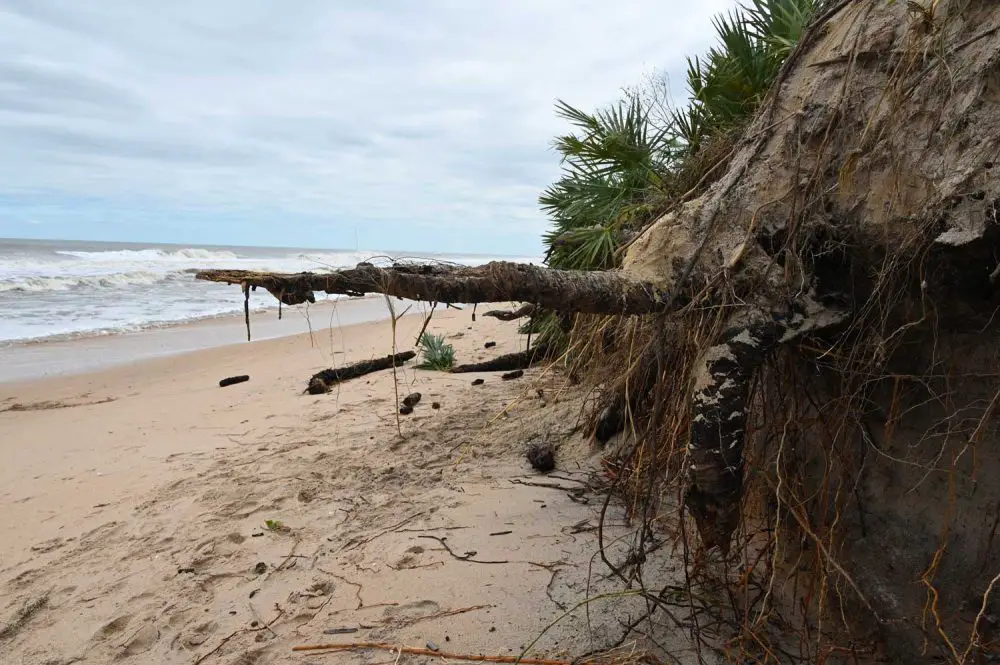
Along Flagler County’s 18 miles of shorelines, the dunes are all but gone.
Inland, Flagler County and its cities fared relatively very well compared to feared flooding and other damage from Hurricane Ian, and especially compared to the devastation and loss of life counties in its path suffered. Twenty-seven people were killed as a direct result of the storm in the state at last count, none in Flagler, where the storm’s effects were limited to 14 to 20 inches of rain and tropical storm-force winds. Roughly 100 homes were flooded in Flagler Beach, a quarter the number during Hurricane Irma.
Demands on emergency services in Flagler and Palm Coast were not as steep and recovery will not be as difficult as in the aftermath of Hurricanes Matthew in 2016 and Irma in 2017.
Along the county’s shoreline, it’s a different story. That’s where the heaviest damage was sustained, much of it out of view of the public but for those who see it for themselves.
It’s also a double-edged story. there was no structural damage to roads or property, because what dune and rock protection was in place did its job, sacrificing itself along the way. The sacrifice in effect masked the foundational damage that did take place. That foundational protection is now gone, leaving the shoreline exposed and extremely vulnerable to the next severe storm.
“We’re down to the last line of defense,” Flagler Beach City Manager William Whitson said.
“There is a lot of danger not only to the people there but also to the environment within our area,” County Engineer Faithal-Khatib said. Sands may go and come back, if not in the same proportions, she said. “But right now I believe we are in very critical situation.”
“Even within the city of Flagler Beach it’s getting much worse,” says al-Khatib, who met with Whitson about the damage Friday. “Some locations are very dangerous to the public even to be standing there next to the sidewalk on A1A.”
It also leaves local officials no time to dither toward protective reconstruction. There are emergency plans afoot, but al-Khatib is not looking for another band-aid.
From the Volusia-Flagler county line to Marineland, Hurricane Ian mercilessly cleaved a new shoreline that obliterated what remained of the 1 million tons of sand the county’s $18 million repairs dropped on 11.4 miles of shore north of Flagler Beach Beach in 2018 and 2019.
A mile-by-mile survey FlaglerLive documented in pictures on Friday, from the Volusia county line to the St. Johns county line, revealed the catastrophic loss of dune protection. Again and again sheer cliffs have replaced dunes and the ocean has advanced on properties and on State Road A1A.
It’s a replica of what took place during Hurricane Matthew, with two differences: first the cleaving is deeper and more uniform along all 18 miles, leaving no area less vulnerable than others except where sea walls were built. That furthers narrows the window of opportunity for repairs and widens costs ahead.
Second, the ocean’s advance now means that in many places, there is little or no high-tide beach left. Though that was the case in some areas previously, as a recently completed beach management study noted–in Marineland and in areas of Flagler Beach–this week’s erosion suggests the no-beach zones are expanding significantly. The damaging economic effects radiate from there: Beach erosion means economic erosion. It means less space and less time for beachgoers to lounge on the sands. It means fewer beachgoers. It means less tourist and business activity along A1A.
In places, the carve-out left businesses like High Tides at Snack Jack toward the south end of the county wrapped in yellow caution tape, its beachside valet drop-off ending in a cliff and the ocean lapping at them below. “That’s another bad situation,” Whitson said of Snack Jack, though he said it’s one of several like it.
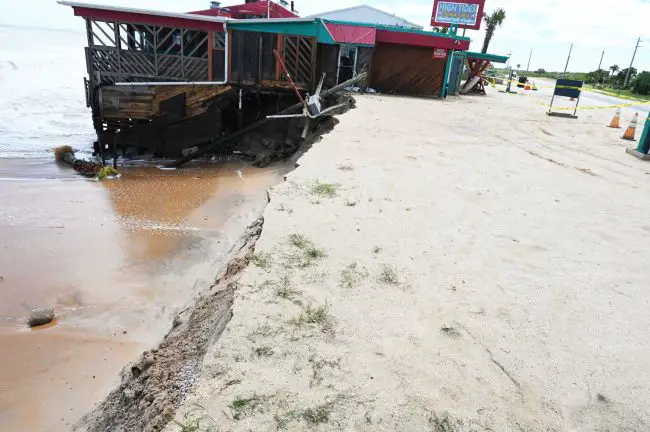
The dunes around the Funky Pelican, the former Pier Restaurant in Flagler Beach, were similarly reduced to cliffs only weeks after they had been carved out by unusual tides. The pier will be closed until further notice. While the city manager says the restaurant is “will be safe to reopen,” the Funky Pelican is also closed for now–it lost its product due to power cuts–with a structural engineer due to look at the pier structure next week.
Of equal concern, potentially dangerously so: There are no dunes left along the Flagler Beach boardwalk north of the pier, only a sliver of land and remaining vegetation. Any Nor’easter, let alone another tropical storm or hurricane, would almost certainly backhoe into the boardwalk and State Road A1A.
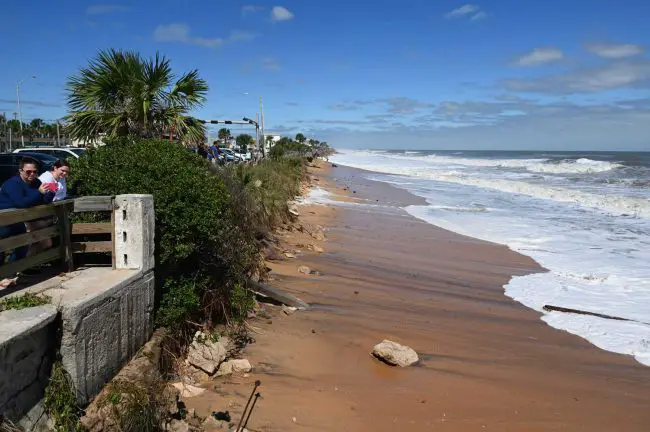
Compare the image above to the image below, taken on August 14, by which time a very large portion of the dunes had already been lost. But about eight to 10 feet’s worth of dunes remained between the ocean and the boardwalk. Those dunes have now vanished:

“That was our concern and it’s just getting closer and closer,” said Tom Gillin, Flagler Beach’s recreations director. “It hasn’t infiltrated A1A. But it got a little bit closer there.” Gillin and Whitson have despaired over sightseers crowding the boardwalk since Friday, and beachgoers and surfers going into the surf despite the hazards on the beach.
“I did see some critical safety issues there,” al-Khatib said.
“I’m having real trouble with all these sightseers that want to come out here act like nothing has happened and go down on the beach. It’s a real challenge, and I wish people would use common sense, but I guess common sense isn’t that real common,” Whitson said. Every public access point to the beach has been closed in Flagler Beach, but still, people go through. “What’s hard to understand about the fact that there’s nails, sharp objects, all kinds of other hazards in the water. Until it gets cleared and cleaned up, people need to stay away from those things, and give us a chance to assess and clean up.”
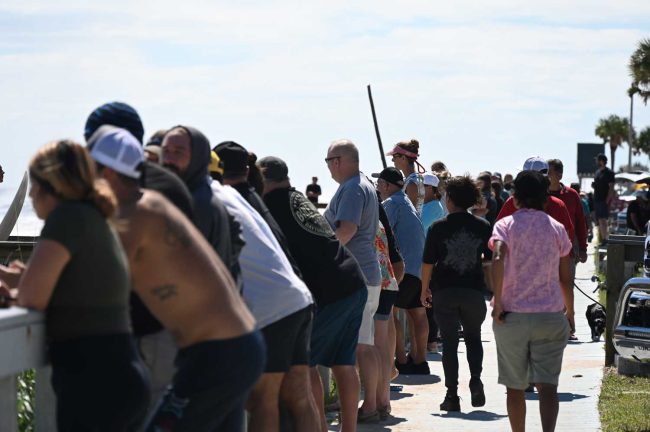
The rock revetment protecting A1A south of the pier did its job, as did the new French drain system running through the middle of the rebuilt portion of A1A south of the pier. But a huge portion of the rocks have washed out, weakening the remaining structure and looking nothing like the way it did when DOT built the stretch of revetment in 2017 and strengthened it again in 2021.
Rock revetments have both slipped down what used to be the dune slope, now sandless, and lost much of their volume, thus leaving critical portions of the edge of A1A exposed and vulnerable to carve-outs even with a mass of rocks further below, as illustrated here. Again, there is no high-tide beach left:
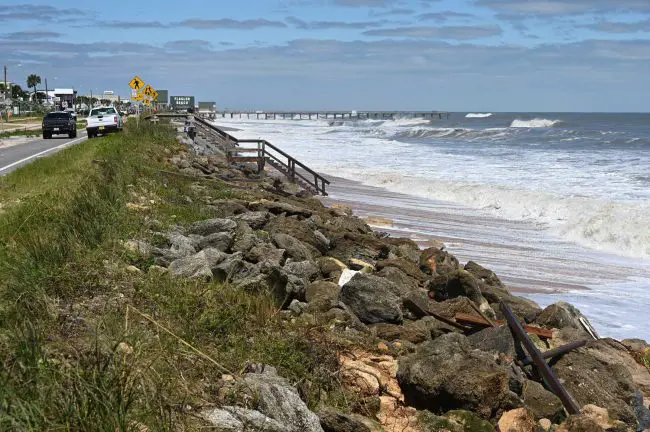
The long sea wall the Florida Department of Transportation built in 2018 from North 18th Street in Flagler Beach to Osprey Drive in Beverly Beach also did its job.
But the rock revetments and massive dunes covering up the wall and sloping down to the beach are gone. The wall’s pilings, 36 inches in diameter each, drilled down to a depth of 36 feet, are now in full view for their topmost 10 feet. The fat concrete cap lining the top of the pilings along A1A remains covered by a thin line of sand and vegetation, but with nothing much to hang on to. There is no longer a high-tide beach between the ocean and the wall:
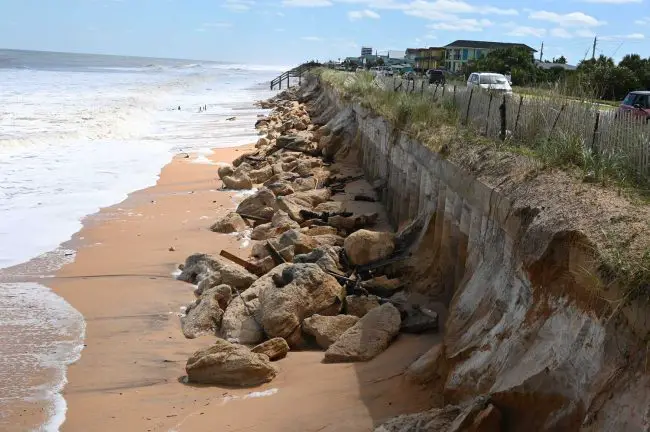
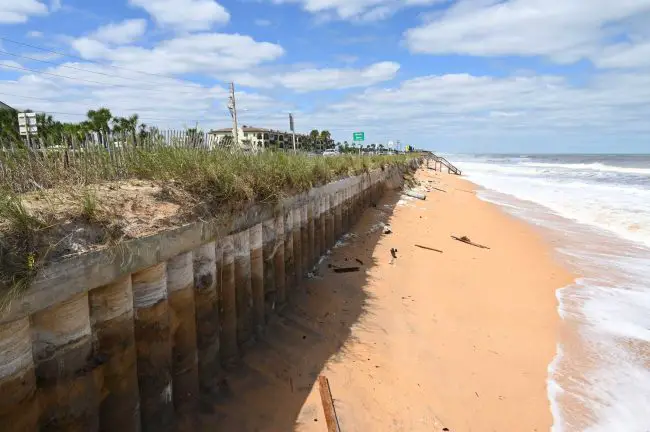
Here’s what the wall had looked like when it was nearing completion, and beach sands extended for more than a dozen feet toward the ocean. The picture was taken in August 2019, when U.S. Rep. Mike Waltz was visiting the project area:

Up and down A1A it’s the same story. Where there was no rock protection, Ian carved out more dunes, and where there were rocks, the ocean took out a large portion.
The loss is dramatically illustrated at Varn Park, north of Beverly Beach, just south of the Hammock, with time-lapsed pictures. The house with a cupola provides a point of reference. Here’s a picture taken in April 2011, when the dunes paralleled a concrete sea wall, all covered in thick vegetation:
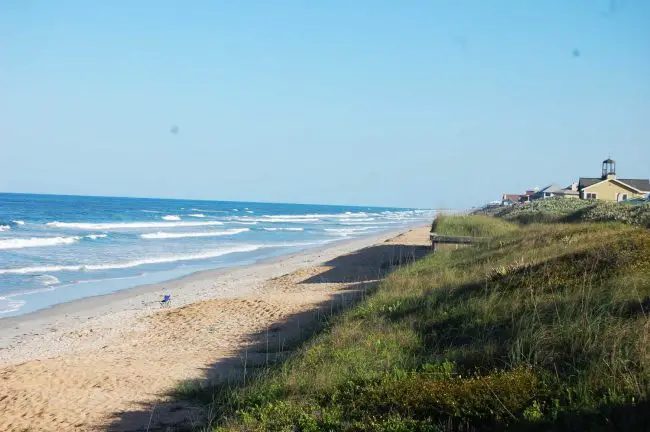
The 160-foot sea wall was damaged by Hurricanes Matthew. It was demolished by Hurricane Irma. Its concrete remnants stood like tombstones until this week. This picture was taken on Aug. 14. While the beach was already diminished by previous storms. The dune reconstruction of 2018 had provided some protection, as had the vegetation that grew since. There was still some definition between beach sands and the ocean, though the volume of the dunes was noticeably smaller:
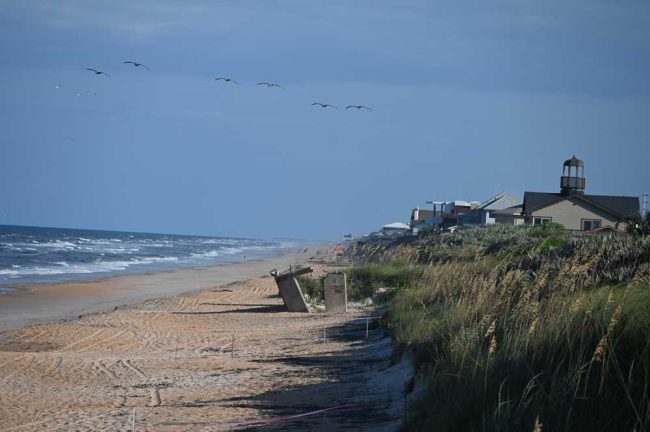
Here’s the same view on Friday, after Ian. The concrete remnants are now hazardous rubble. Any hint of the 2018-19 dune rebuilding with white sand has vanished. More alarmingly, larger parts of the dunes have been carved out as the ocean advanced further on properties than it had after Hurricane Matthew. There is no definition between ocean and dune cliffs. There is no high-tide beach:
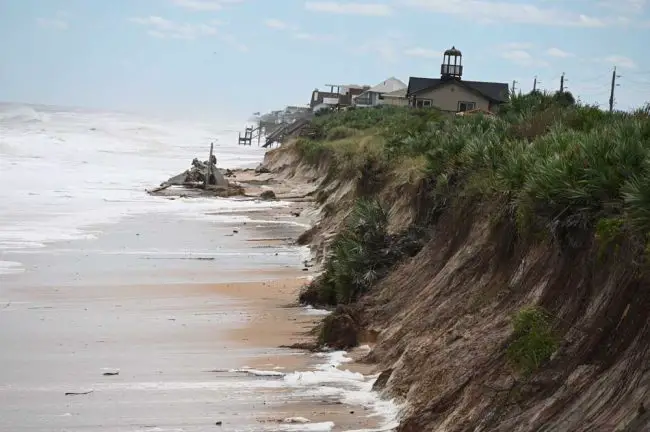
At Jungle Hut Road, the loss of dunes is told in several ways. There is the length of walkovers that now walk over a void. There is no hint of the white sands dropped during the 2018-19 rebuilding project, when the original dune wall, even after Matthew, was closer to the surf line:
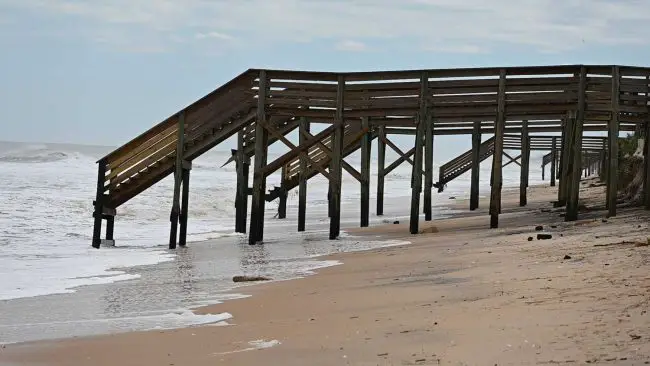
The Jungle Hut Road entrance to the beach in 2017, after Hurricane Matthew, just before Hurricane Irma:

Ahead of Hurricane Ian, the county had dumped truckloads of new red sand to block a potential breach at Jungle Hut Road. The day after the storm passed, visitors were navigating the small cliff.
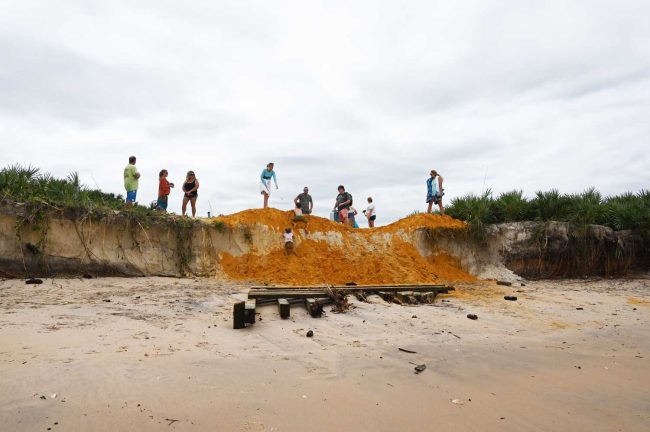
Here’s a brief video of the damage of the dunes around Jungle Hut Road:
The beach at Old Salt Park in front of the Hammock Beach Club was also reshaped. Here it is in July 2011:
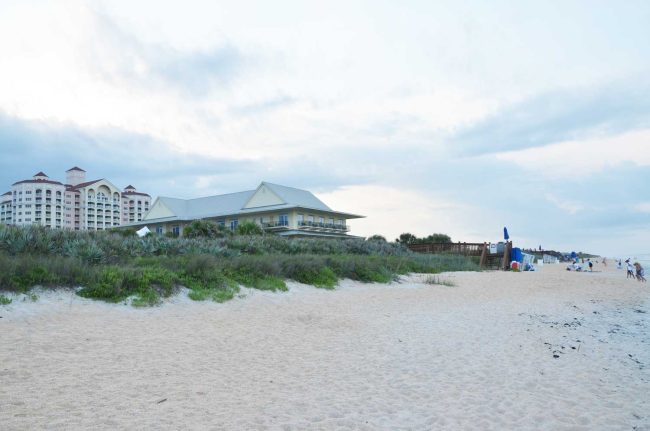
Here it is Friday:
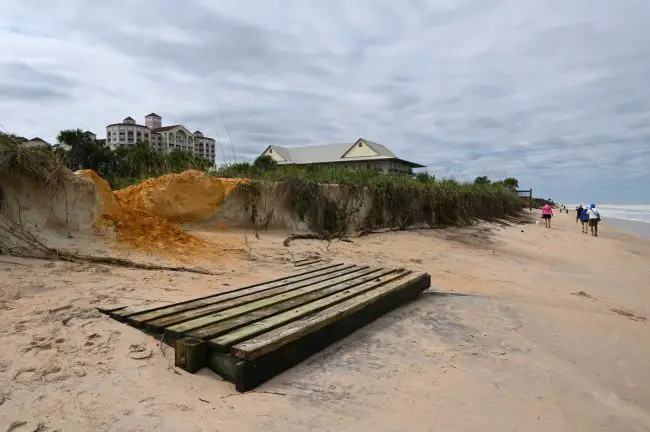
Further north, the small community of hardy ocean-defiers north of Sea Colony lives along a half dozen dirt roads–Bay, Surf, Rollins, Flagler, Atlantic, drives Moody. Many homes are elevated on concrete stilts in deference to the expected flooding there. Several roads were flooded in parts on Friday, as were a few yards, but not as much as in the aftermath of Ian.
By the ocean, however, the once protective dunes were diminished to nothing in parts, to the point that, in the case of the house at 66 Moody Drive–a 3,000 square-foot house built in 2000 and currently valued at more than $1 million, according to the Flagler County Property Appraiser’s estimate–there is no difference anymore between beach, dunes and house property. The house’s front porch is the beach. The dunes are entirely gone but for tufts of vegetation, presenting no barrier to tidal waves:
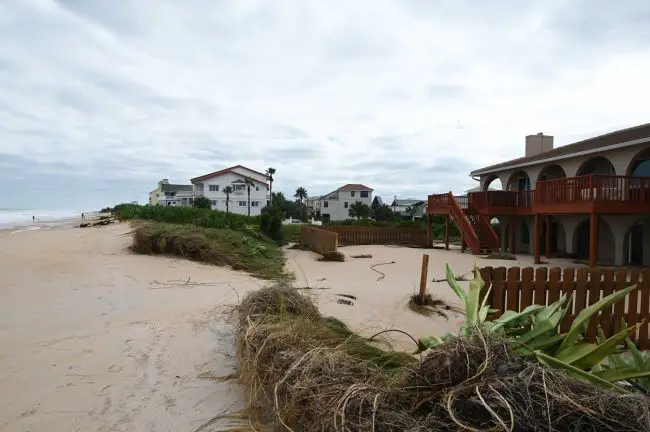
The final heartbreak is in Marineland, whose park had once afforded county residents and tourists one of the more expansive, rustic red-sand beaches in the county. That beach is gone, its undergirding coquina rocks now fully exposed.
Here’s what the beach in front of the Marineland boardwalk looked like in 2010. It’s dunes were healthy, thickened with vegetation. Beach sands sloped far toward the sea. beachgoers had plenty of room to spread out and lounge on fine, soft white sand. Note, too, the expanses of undulating, vegetation-covered dunes to the right:
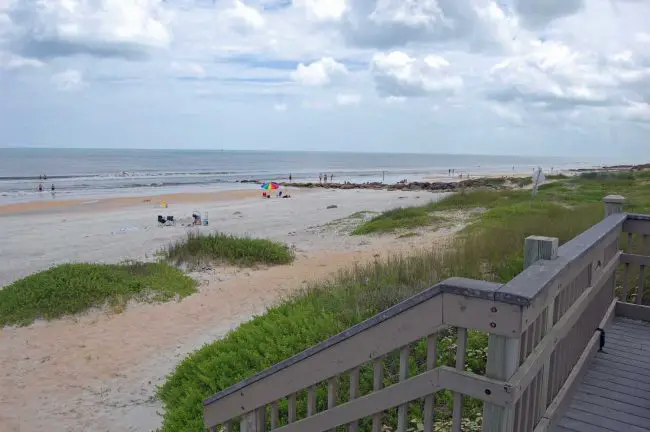
Here is the beach at low tide on Friday afternoon. The dunes, which had severely eroded over the years anyway, are entirely gone, as is the covering beach sand. But for its color, the shore looks more like Maine than Florida:
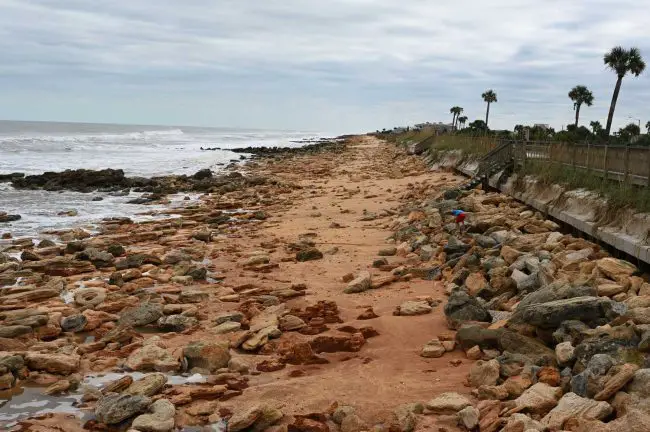
Marineland since 1935 has been protected with a 1,350-foot-long rock revetment north of today’s boardwalk, plus five jetty-like coquina groins spaced at 400-foot intervals. Hurricane Floyd in 1999 destroyed the Marineland boardwalk and much of the revetment. The storm also took out portions of State Road A1A. (Floyd also sheared off the 48-foot T-shaped section of the Flagler Beach pier’s eastern end and damaged another 100 feet of what at the time was an 848-foot structure only three years after a mere storm had taken out 125 feet of the pier.) The town has had its challenges, and continuously met them with state help, if at growing expense. As late as last November 9, marineland’s shore along the boardwalk had looked more protected by a ridge of dunes:
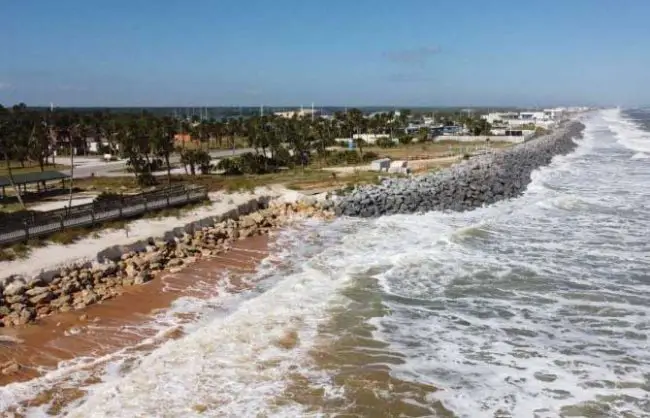
So while Flagler County was spared the brunt of Ian’s fury, it’s on the shoreline that the heaviest cost will have to be tallied and paid, if the county, Flagler Beach and Marineland intend to protect properties, roads and the mainstay of the county’s tourism industry, which depends on broadly accessible beaches.
That’s where the U.S. Army Corps of Engineers and Flagler County, who were poised to begin a dunes-reconstruction project next June on 2.6 miles of beach south of the Flagler Beach pier, will have to yet again re-calculate the amount of sand volume they will need to do do the job, upping the volume by huge amounts, and with it the cost. That needed sand volume had been more than doubled doubled to 1.2 million cubic yards before Hurricane Ian, because the project has been delayed since it was funded in 2017, and much erosion has taken place since. That sand volume may have to double yet again.
“That’s why the Corps of Engineers called me and we’re going out there to the field to inspect the Corps of Engineer project location,” al-Khatib said. “The volume has to increase. How much? A lot. A lot has to be increased. Exact cubic yards, we have to do some surveying and to compare that with previous existing surveys.”
That’s the case not just for the 2.6-mile Army Corps project, but also for the more lengthy project the county secured, with money from the state Department of Transportation, to cover the dunes from south of the Army Corps limit to the Volusia-Flagler County line, and north of the project, from 6th Street South in Flagler Beach to near Beverly Beach.
With any increases in needed sand with come huge increases in costs. The U.S. Army Corps project is funded by the federal government at 65 percent. The rest is Flagler County’s responsibility. It has secured that 35 percent portion previously by securing state grants. It had done likewise with the DOT project. Now it has to go back to begging for money, which takes time and political clout. It has the clout, now that Paul Renner, Flagler’s representative in the Legislature, is the speaker of the Florida House. It does not have the luxury of time.
And al-Khatib is not interested in half measures: the $18 million effort to rebuild the dunes in 2018 and 2019 was impressive, but it has not vanished. “It doesn’t make sense to go and do also a band aid project there,” the county engineer said.
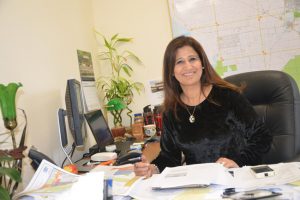
“This is very serious. We need to team up and work together, us with the private sector, to take care of our dunes and beaches,” al-Khatib said. But it’s all about the funding, she said. The county has a beach management plan in place. It even has projects set to go. “In Flagler County they have to decide how they want to do it. Design, permitting, the whole process, us as engineers, we know how to get these things done. But again, the money. Is the money available? Can we get it in a timely manner? After this event I got some emails and some pictures from people and everybody in the private sector. They will tell me like, oh, look what happened, what can we do? But I advise anybody who lives right here in the dunes and they own the property to do whatever they need to do right now to protect their property during this emergency situation.”
That includes no longer holding out on signing the sort of easement document that will allow the Corps of Engineers to move forward with its project in June, rather than face yet more delays. It includes the signing of similar easements in other segments of shoreline the county plans to rebuild. It includes no longer talking about the beach management study submitted to the county in August, as the County Commission has done for months and years, but defining a plan and finding new ways to pay for it, including with local dollars.
Jim Hinton and his wife Ann have been residents of Surfside estates, the manufactured home community in Beverly Beach, on and off since 2011, and permanently since 2015. They weathered the devastation of Hurricanes Matthew and Irma, both of which did significant damage at Surfside. Hurricane Ian was not as damaging, its effects limited to some roof damage–including to Hinton’s home–and some water rising at the west end of the community, but not dangerously.
Originally from Douglasville, Ga., Hinton was working around his property Friday, just back from two nights on the mainland. “I’m staying here until my daughter comes and get us,” Hinton said, thinking he’d be here for many more years. But after a pause, he said: “Sometimes I think it’s time.”
![]()
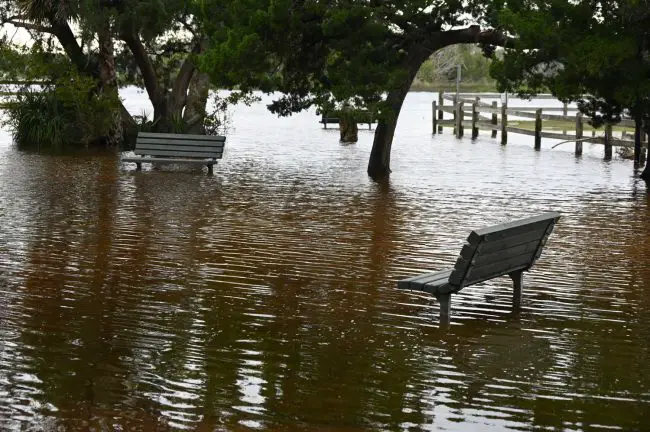





























Lisa K says
The definition of insanity is doing the same thing over and over again and expecting a different result. – Albert Einstein
jOE sTOLFI says
**** .. .. BEST COMMENT HERE .. .. ****
The ORIGINAL land of no turn signals says
Biden signs new 41 million dollar bill to help Illegal alien’s fight being deported what a great country.
c says
Please divert all diversionary tactics to the diverting lane to your left. Thank you
Kz says
The word illegal says we should send them home
Sorry
Marlee says
huh?
WTF does this have with beach erosion?????????????????????????
The Truth says
What the HELL does this have to do with the dunes?
The dude says
Yes… it is.
Steve says
The Party of No. No Agenda. Deflection and Projection is all they have. Deny, Accuse, Deflect, Project and lie.
jeffery c. seib says
I know a Trumper when I read garbage like this. The illegals you speak of are refuges given temporary asylum into the USA. This money is to keep the border mess under control. Trump, as with most things, did nothing but whine and work up people like this. He is also putting billions into the science of climate change.
DaleL says
The 41 billion (not million) dollar bill kept the federal government open. It provided extra money for among other things: border SECURITY and federal disaster funds (FEMA). The extra money will help to process the backlog of immigration cases. This will expedite the deportation of illegal immigrants and the settlement of legal immigrants. FYI, it is a felony to knowingly transport illegal immigrants. None of the immigrants flown to Massachusetts were illegal immigrants.
Many Floridians need help from FEMA as a result of hurricane Ian. Both of our US senators, who voted against extra funding for FEMA, have now requested increased help for Florida from FEMA. Our governor, when he was in Congress, voted against additional funding for FEMA to assist the people in New York who were devastated by hurricane Sandy.
To plan and build for the future, we need to work together. It will cost money to properly prepare for the next storm. Without human construction along the beach line, the dunes would naturally rebuild a little farther inland. Now because of the rocks and sea wall they cannot. Thus we (Flagler Beach, Flagler County, State of Florida, Army Corps of Engineers) have to decide the future of our coast.
Denise says
Thank you for sharing the facts.
ASF says
It means not letting one lot property owner who has been holding everybody else hostage get away with causing mass destruction. I suggest that that property owner be held legally and financially accountable for the damage they are causing. If they personally find thesmelves on the hook for paying for the coinseqeunces of their actions, Flagler Beach might begin to se emovement on cinservation efforts–if itls not already too late to mitigate the damage done by these delays.
Wow says
Also terrible for the sea turtles who have no home beach to return to. Very sad.
JimBob says
I’m befuddled! We’re being assailed by either God Almighty or Mother Nature, betrayed by Joe Biden or government bureaucrats, and pissing away our assets to support Ukrainian children, the State of Israel, and other less than white ne’er-do-wells. It must be the Jewish space lasers creating havoc as Ms. Greene suggests.
Facetious Fanny says
Well its a darn good thing climate change, global warming and sea rise have all turned out to be a colassal hoax perpetrated by the Clintons, Bidens, and libs. Otherwise we’d be wasting a massive amount of money with all the rebuilding. Lock them up!
Pat Tomnay says
Why, oh why, are you turning such a disaster into a political debate? Businesses and others will be hurt by this – show a little mercy if you have any. Leave politics out of it, PULL – EEASE!!!!!
Dave says
Because a lot of people are assholes and do not care about anyone but themselves. , its the new USA. Rudeness is running a muck in this county or what we have left of it. They are stuck in their own little pathetical bubble driven by a new way to just hate others via online forums, chats etc..
Any way the dunes, can be fixed if some thought is put to it. Not some Flagler County cheap talk that they have done for the last 2 years, which is meeting promises with no action. At least get the dirt piled back up and make it a priority and not just talk smack and then start looking at a real solution for 2023, and sand is not it. People are losing everything and being displaced and that is real.
James says
“… With any increases in needed sand with come huge increases in costs. The U.S. Army Corps project is funded by the federal government at 65 percent. The rest is Flagler County’s responsibility. …”
Yup, doesn’t come “cheap.”
Celia Pugliese says
The beach front sand needs to be restored…for the people and also marine life. Very simple other than wasting billions, trillions and lives in useless wars out in Asia and allover the world is time we secure our land instead first, generate local industry to secure jobs and sell for export to earn the funds that we need at home. Other than billions for elections campaigns we need to do away with that (no one person, corporation or entity can contribute more than $10 to anyone running for any office of any party) and use donated billions and federal taxed funds to repair hurricane damages in our public common areas like the beaches, etc. We can do it if politics do not intercede. Stop the theft of funds assigned for the needy for sports stadiums etc. : https://search.yahoo.com/search?fr=mcafee&type=E211US91088G0&p=Needy+funds+used+for+a+soprst+stadium.
This one was uncovered imagine how many more go unnoticed! https://www.nytimes.com/2022/09/22/us/brett-favre-welfare-mississippi.html. The taxes we generate are dilapidated everywhere in frivolous uses then we do not have those funds for emergencies. With all the wasteful high paid administrative positions in our government sustained by our hard earned taxes these things take place not enough high paid watchdogs? Maybe many of the wasteful VIP paid should be done away with and billions will be saved to be applied to proper use. Is plenty money out there to repair our beaches after hurricanes if some honesty will stop the theft and also few useless wars funding. Repair our beaches! We need them more for our people that sport stadiums that should be self funding. Now you can kill the messenger…
Steve says
IMO Trying to save the Coast is a long lost cause. Mother Nature is in control
Andre says
Maybe it is time to contact the Delft Hydraulics Laboratory, now a part of engineering group Deltares (www.deltares.nl site is available in English),
which is one of the worlds best known knowledge centers for water protection and have them study what needs to be done for a working solution. Just adding sand is useless, as has been learned now. Protection against the ocean needs a total solution to work.
DaleL says
Celia, your comment concerning campaign funds is off topic, but worthy of discussion. The idea of taxing political campaigns is a non-starter. There are already donation limits for a candidate’s campaign. However, political organizations (PACs) are another matter. Perhaps they should be treated under the law as though they are regular companies. All contributions to them could be treated as taxable income.
It should be obvious that the beach dune line has moved significantly over the last 50 years. The Flagler County Appraiser has an interactive map which shows the location of property lines. Properties, which are beachfront, include land which is now literally under water. The map has aerial views from 2005 and 2020. Sea Colony, a gated community in northern Flagler County, owns common land along the beach. In 2005, at the southern end, the land had about 50 feet of vegetated dune. The same location in 2020 had maybe 20 feet. When our Appraiser updates the map with a more recent aerial photo, I’m confident that the amount of vegetated dune will be even less.
Our planet is dynamic. Our beaches are no exception. We have a choice. Option one is to replenish the beaches as was done after hurricane Matthew. Option two is to fortify the beaches with rocks and seawalls. Option three is to retreat when necessary.
Jerome says
Maybe the check for the border wall will help !!! Or what about the 135 million t-rump spent on golf !!!
Skibum says
This shows that man’s ability to engineer safeguards in coastal beach areas is certainly no match for mother nature and the fury of major hurricanes. With climate change strengthening storms every year and ice melt eroding glaciers at an alarming rate that will raise the sea level, we can spend billions and billions of our dollars to no avail to try to save structures and roads built too close to the ocean. Will I-95 soon become as close to the Atlantic Ocean as A1A is today? Only time will tell, but what the oceans are showing us does not portend to be in man’s favor.
Robert says
[WARNING: The following comment is based on a false premise–that there has been negligible sea rise the last 30 years. Yes, it can be proven how much sea levels have risen. As Sealevelrise.org has documented, “The sea level around Florida is up to 8 inches higher than it was in 1950.” Around Virginia Key, for example, “speed of rise has accelerated over the last ten years and it’s now rising by 1 inch every 3 years.2 Scientists know this because sea levels are measured every 6 minutes using equipment like satellites, floating buoys off the coast, and tidal gauges to accurately measure the local sea level as it accelerates and changes.” Personal observations are not a substitute for science.–FL]
Can you prove to me with actual transit elevations how much exactly in feet or inches how much the ocean level has risen? I’ve been her for 32 years, and without the benefit of a transit, my estimation is the sea level hasn’t changed 1 CM +/-, what has changed however is the elevation of the beach surface at tidal change area up to the dune line.
Examining the water level marking on the pilings for the pier, the oceans high/low tide elevations have not changed by even 1 cm. However the sand elevation at the piers supports have diminished by approx. 3’. We are not seeing sea level rise so much as we are seeing sea bottom being eroded and being dragged off shore. What Mother Nature appears to be doing is trying to build another barrier island approx. 2,000 feet of shore. A good portion of the sand deposited in 2018 & 2019 was not swallowed up by the ocean and digested, it sits about 1,000 – 2,000 feet off shore, one only has to look at wave action to see this is happening.
Rather than trucking in another 1 million cu. yds. Of sand, why don’t they reclaim what the ocean has taken, it’s just sitting off shore.
I agree with what one commenter wrote “ the definition of insanity is doing the same thing over & over & over again expecting a different result. Which is exactly what the minds behind these beach renourishment projects are. I remember when they were lining the dunes with silt fabric and placing boulders on the sea side of the dune some the size of VW Beatles, that was back in 1998, who was the rocket scientist who came up with that idea?
We all witnessed the result of those efforts a few years later when in that exact same area those VW size holders along with the silt fabric disappeared, and the ocean are away at A1A better than half way across to roadway to a depth of 20’ or greater.
So what did the do both of the pier, the exact same thing. Stupid is as stupid does!
I cannot do anything but laugh at the abundance and rampant stupidity! Where is the county and Flagler Beach finding these engineers, the obviously have no experience working with the ocean. The methods may apply well with Lakes, BUT NOT THE OCEAN, where the water is in perpetual motion.
Although there no way to stop the objectives of a body of water the size of the Atlantic Ocean, but there is a way to slow its inland March to reclaim land it deposited here eons ago.
I see two potential solutions to slow the oceans progress inland. 1.) regular beach grooming, maintaining a level plane along the entire distance of Flagler County beach, instead of allowing the beach surface of a ski slope, dotted with morals, thus accelerating the rate of erosion, particularly at high astronomical high tides. It’s far more difficult to erode sand from a level surface than a mountain side. This has proven factual based on archaeological studies as to how mountains over time are eroded into a level plane. I call it equalization by Mother Nature. Just as cold seeks warmth, and warmth seeks cold to equalize temp.
That’s why that ice cold can of ice cold beer taken out of your cooler very quickly equalized tithe ambient temperature.
Having said that, only the stupidest amount us would disagree that the source of our beach problem stems from surf acting on the beach! So those that would be inclined to disagree, please reserve your comments.
So considering that we are all in agreement, that the surf is the culprit, is there anything that can be done to mitigate its effects on our shore line?
I’m glad I asked myself that very question! Having spent a good portion of my summers growing up on cape cod where my parents had a summer home, I quickly learned why cape cod still exists to this day.
Our home was located in North Falmouth, MA, for all you sufficient in geography the is known by the locals as the outer cape, as opposed to inner Cape Cod, IE: Denis, MA., I’ll leave it up to you to geolocate those areas on the map to understand what I mean by inner and outer cape.
What Yankee enginuity has discovered worked well for the is the construction of “Jutties”, which are nothing more than a pile of rocks, some the size of VW Beatles, but rather than line the dunes with them (a process that failed disastrously here after the 1998 beach restoration) the Cape Cod Indians employed a different technique. They placed the rocks jutting out from shore, they aligned them in such a fashion that they projected from shore at an angle that would be in opposition to the angle that the surf of the most beach damaging surf would come from. I this case, the damaging surf would come from the Northeast, so they placed the jutties in a south easterly direction. The projected out into the ocean approx. 400’ -500’, roughly 30’ to 40’ wide and 3’ above the hugest recorded tide.
Essentially whit these jutties did is break the surf as the waves crashed into the rocks, as opposed to them crashing on the beach. Thus almost eliminating the need for sand replenishment.
To the best of my knowledge those sone jutties have been there since 1938, after the Devi station that hurricane imposed on the Rhode Island & Massachusetts shore line. These structures are common sights on the cape code shore line, and I believe it’s what has prevented Cape Cod from becoming an Island.
My suggestion at this point is to talk to the designers of the Dubi islands, apparently they have developed a formula that prevents the islands they are building from being reclaimed by the Sea. I think employing the technical skills of these developers will provide far better solutions than the ideas proposed by the engineers the County and Flagler Beach has engaged to date! It’s worth a try, as the State, County, and Flagler Beach cannot continue to experiment with efforts proposed by engineers which have proven to have failed disastrously to date. It’s time to try something different. Just my 2 cents.
Laurel says
Robert: I know that beach *re-nourishment* does work in south Florida, as much as I don’t like it. The light, gold sand is now grey, but it’s a much longer walk to the shore than when I was growing up there. I don’t think it’s going to work up here. Keep in mind that Marineland’s beach has minor jetties, which are now nothing but a scattered mess on the beach.
South Florida has the Bahamas to act as a break, changing the wave structure. Here, we don’t have that and the waves deeply scallop out the beach on a normal day. In South Florida, the water is deeper faster. You can take your boat offshore, be in 80 feet of water and still see the shoreline and buildings. This deeper water has more of an effect of wave choppiness, and the waves are not as large as they are when you travel north. Ask any surfer! The Gulf Stream also veers off to the northeast once you get to Lake Worth. This Gulf Stream must also have an effect of changing wave structure as it has its own strength and path. Surfing is better on the north side of the Gulf Stream turn off. Here, you must go far off coast to get in deep water which has nothing to block the structure of waves, and the waves have more energy.
So far, the work done here has saved the road but will do nothing to save the beach. Jetties may have some effect as well, but I’m sorry to sound pessimistic, but I doubt there will be much that will save the erosion here. Sometimes, Mother Nature returns sand but the ocean is rising and we’ll never see the same structure as before. I have lived in Florida more than twice as long as you have. Climate change is real, and as I have written in other comment here, that I’ve never see such flooding in this state as I have seen in the last several years. Even on Miami Beach, is wasn’t as bad as it is now.
It will take some master engineering to change things, but I agree with you as far as it’s not happening yet.
Robert says
Let me propose a thought with regard to sea level rise, (although seeing no physical evidence here in Flagler of that occurring. Based on 47 years in the construction industry)
Perhaps it’s not global climate change, polar ice caps melting and the like. But rather surface water runoff, that is causing sea level rise. When you examine aquifer levels dropping all over the planet, wells going dry as well. The pure underground water is being consumed faster than nature can regenerate it.
Now let’s just think back 70 years and make a visual comparison to today. Would you agree that County, state, national, and world wide the state of developed land has expanded exponentially? I doubt you could find few who would disagree. But let’s just look at Flagler, the conversion of forested land now dedicated to commercial space, in addition to the residential space that has been constructed in the past 70 years. Now calculate the surface area of water impervious surfaces that exist today that was non existent 70 years ago. I’m talking roadways, streets, driveways, roofs, etc. all the rain that falls on the impervious surfaces creates runoff that would have in the past been absorbed by the ground and ultimately replenished the aquifers beneath us. Well this runoff is now being directed into bodies of ocean water instead of seeping into the ground. There you have your explanation of sea level rise. Makes more sense than Al Gore’s stupid climate change, coming from a man who has never picked up a shovel or build a single thing in his life. Further you must that sea level rise cannot be localized, as the ocean is a giant level. Water cannot rise more in a certain geographical area as opposed to another, sea level is self equalizing.
Rather I believe some areas are experiencing greater rate of sea bed erosion than others, resulting in surf further claiming more and more land. Like I said my viewpoints are based on my own experience of 47 years in the construction industry and the runoff issues faced when converting undeveloped land in shopping malls, strip malls, housing developments, and even single family stand alone homes. The surface runoff we are creating is enormous volumes of water runoff. One only has to look at the coastal flood warnings the weather service is posting that we are still experiencing some 6 days after the storm, the ocean can only accept so much water at a time. Which explains the high water level of the inter coastal waterway nearly a week after the storm.
Laurel says
Robert: I totally agree with you as far as impervious areas are adding to the problem, my former career was assessing these areas. That is not the end all, be all, though. This planet is a small one, with an extremely large human population that has little regard for its health. In the simplest terms, if you have a fish tank, and you do not clean up the waste on a regular basis, the water turns and the fish die. People used to say “The solution to pollution is dilution.” Too late. Rain runoff is not enough to rise the sea level. Melting ice caps and glaciers are. But, as someone who was in the stormwater business, I would stand with someone in the construction business to curtail impervious areas.
Harry says
The people making the wrong decisions are all graduates of t-rump university !!!!
A.j says
People are always blaming the left. Regardless to who is in power God is going to do what he is going to do. We can’t stop God. Blaming people will not help the situation. We need to be ready as best we can. People who has been in this world for sometime know Fla is in hurricane ally. As I know of it has always been that way the blaming game dosent help anybody. Ian isn’t the first hurricane to hit Fla it will not be the last. I saw on my phone where two white women said the deep state is responsible for ian. Wow what a shame. If we can control the weather I don’t believe the fires would be raging in the west and the floods and drought would meet and provide good fertilized land. They said it was against the conservative states like Fla. Last time I checked Fla was a swing state. Let us work together toward a common goal of helping each othet.
Billy Joe says
REALLY? God does not cause disasters, A.J.
Robert says
Since you brought up the deep state let’s discuss it! Are you aware the the government has admitted that it does have the ability to manipulate weather. Are you not aware of chemtrails as opposed to contrails, which again the government has admitted doing, are you not aware of wars being created for the acquisition of natural resources or the enrichment of the military / industrial complex which even Eisenhower spoke of in the 1950’s!
Keeping you head buried in the sand and then pulling it to say in essence that the government is our friend, they are doing everything to better our lives! I would expect that from a 12 year old but not an adult. This is the problem world wide, people are dead asleep and are total ally unable to comprehend what is being done to us. It’s been on going for the past 6,000 years, and we are nearing the fulfillment of their globalist plan.
Whathehck? says
Since comments have turned political I will agree with Celia Pugliese.
In his 2016 budget, President Barack Obama proposed getting rid of tax-free bonds to help finance stadiums, a practice that costs the U.S. Treasury $146 million a year, according to a 2012 Bloomberg analysis. Bloomberg calculated that the $17 billion in tax-exempt debt used to build stadiums since 1986 would cost taxpayers $4 billion. The idea, like most of Obama’s budget, failed to gain traction in the Republican-dominated Congress.
Once the team left, Missouri taxpayers shouldered the remaining $144 million in debt and maintenance costs on the stadium until the debt was paid off in 2021.
There is money to protect the USA from global warning and sea rise, keep an eye on all the politicians.
Denali says
Someone has to be the contrarian here so it might as well be me. Before going too far allow me to say that I do care about the folks who have lost or are about to lose their homes or businesses – but honestly, they were forewarned that nothing on the beach is permanent. Just to our north is a perfect example; Matanzas Inlet has moved 2 miles south in the years since the Spanish built their outpost on Rattlesnake Island.
What we perceive as horrible damage is just old Mother Nature doing her thing. People who have built on the islands did so with only an infinitesimal vision of what happens at the ocean / island interface over time. These are barrier islands folks, they move, they shrink, they grow. Nature put them there to protect the mainland and possibly for our enjoyment but not for us to exploit and alter. Anything built on the beaches should be considered as temporary. Why insurance companies continue to insure these properties for physical damage is beyond comprehension. Yes it is painful to watch people lose their property but by golly they rolled the dice when they decided to live on the beach. Sure, all may be good for a decade or two and then, the big one, and their house is gone. Sooner or later a decision will have to be made and the owners of these beach properties will need to be cut loose from the public trough. Again, this is not being callous, but simply pragmatic. What happens after the next storm when the island has moved out from under their house and their lot is under ten feet of water, permanently? Does the taxpayer buy their lot?
Our county engineer does not want to follow the band aid approach which is admirable but anything man does to try and tame the ocean is just a band aid. The revetments at Marineland lasted 80-some years and now where are they? That concrete ‘wall’ built by FDOT in north Flagler Beach is now exposed and open to scouring, how long will it last? We can continue to pour money into the ocean but will never win or break-even in the fight. How much is enough? $100 million this year, $150 the next? Pretty soon we are talking about real money here and eventually the taxpayer will say enough. All we can do is delay the inevitable.
And then in 30 or 40 years when the ocean level has risen to their doorsteps are these folks going to be looking for another bail-out? Of course they will . . .
Skibum says
You are exactly right, and very well said! As I was reading your comment, it brought to mind an interview with one Ian survivor living on Sanibel Island. It was just 48 hours after most of the barrier island was destroyed and completely cut off from the rest of civilization after the causeway coming from Ft. Meyers was taken out in at least 4 places by the hurricane. And you know what this resident said? It’s been 2 days, where is FEMA? Where are the resources the island residents should be seeing for help? Just completely clueless to the fact that nobody could even get to the island by road any longer. When people choose to live in what they percieve to be idealic, scenic areas at the ocean’s edge or on vulnerable barrier islands without due consideration to the plain fact that their property and their lives could certainly be at risk by building there, you feel for them during a tragedy such as what just occurred. Then, after reflection you also acknowledge that they chose other considerations as the priority over safety, and made a fool’s bet that Mother Nature would not dare harm they or what they built on that stretch of sand. All of the people who have homes and businesses right along A1A are increasingly in harm’s way from the encroaching sea and the ever-present danger associated with Atlantic hurricanes, and when and if they decide to stay the course, they should not depend on local, state or federal help to get them out of the mess they should have foreseen coming during these catastrophic, destructive storms.
Laurel says
Skibum and Denali: I beg to differ. I am on the barrier island, and our home did not flood. Our property did not flood. Can you say that for Palm Coast? We consciously built our home with storms in mind, and our first floor elevation is nearly 12′. What’s yours? Do you know? When purchasing a property, it’s called “due diligence.” My guess is that a lot of Palm Coast home buyers have not done their due diligence.
We have not looked to government for help, not once. Here, you are assuming a whole lot. We have paid for insurance for longer than I have cared to think about, but have not made a single claim. For you to ramble on about barrier island people making “fools bets” while your streets flood is offensive.
Skibum says
Thank God you were safe… so far. However, you need no further evidence of your risk living where you choose to build than to price insurance for your home and a similar built home away from the ocean’s edge, not on a barrier island. Building 12 feet above ground may be enough to protect you from the worst of the flood surge in the event of a strong hurricane, but how about hurricane force winds? It is warm ocean waters that increase the severity of these storms, and land that diminishes their strength, so the closer you are to the ocean, you have the potential for a far more severe impact when a strong hurricane is headed in your direction. I sincerely hope you never have to experience a catastrophic loss like those who live in SW FL experienced, but your risk is certainly greater by building where you did. And I assume you know that because you built your 1st level 12 feet up in the air, not just so you could have a better view, am I right? And by the way, neither I nor anyone in my area was flooded. I know a lot of people here in Palm Coast and do not personally know anyone who had flooding issues. Sure, some low-lying residential areas did get flooded, but as you said, you do your due diligence before locating when moving into a new area and your chances of mistakenly moving into an area that has a history of flooding is almost nil.
Laurel says
We built a concrete bunker; Ian was not our first rodeo. We have lived along the coast in several different places, and we have not lost a house yet, and so far, after all these years, we have only lost a portion of a fence which we built back ourselves. The view is a bonus, also a part of the consideration. That, risk, location, drainage and whether the soil is impervious or not, elevation and design were all of the consideration. We designed this house ourselves and acted as owner builder. You cannot make blanket assumptions and try to regulate other’s lives with that assumption.
You may not personally know of anyone with flood damage in Palm Coast, but all you have to do is look at the pictures on this website.
I’m aware of the warmer waters and climate influence, I was born in Florida.
We do feel heartbroken for some of the scenes we’ve watched on TV. One of our favorite places to tow the boat is Matlacha (which translates to knee deep water) which barely exists anymore. To see the destruction of the familiar buildings, which are barely recognizable now, is incredibly sad.
The fact of the matter is, places like Matlacha, Mexico Beach and the Keys are going to have homes, businesses and people as these places are so beautiful and people have lived there for ions without harm. Yes, that’s changing. The Keys are more vulnerable, we know that, but Mexico Beach and Matlacha have been bypassed by most storms. This is not going to change. You cannot keep people from paradise, it simply will not happen.
Paula says
So true!!
Hmmm says
Nature didnt make it. The Intracoastal is for the most part was man made. The only parts that arent man made is were they connected pre existing waters.
Beach Cat says
We are grateful to Pierre for the images of before and after the latest storm. Yes, it is devastating news regarding the loss of dune restoration, loss of wildlife protection and the question of rebuilding. For those cranky GOP folks chiming in with their constant harp about ‘illegals’ joining our country, there are more than 100,000 jobs available just in the hotel and restaurant areas, to say nothing of other businesses needing workers. Those immigrants will be happy to work and pay taxes in our racist country.
Local says
Problem is that most likely won’t be paying taxes and will be sending most of their extra money back to their home countries. That’s money out of our economy into other countries economies.
AAs far as global warming or climate change or whatever they call it these days…..it’d a natural process….if Yellowstone erupts then it will be global cooling they will use to line their own pockets
Laurel says
Local: “…it’s a natural process…” No, not in one person’s lifetime. This is definitely man made. The west has been on fire for three or four years now. Nothing natural about the frequency, and intensity of these fires.
Well, I guess the US Forestry could rake the forests as Trump remarked.
Army Sttong says
It’s sad that democrats make everything political. So sad.
Gary says
It’s insane to try to fix a bad idea. A1A is simply too close to the ocean! The road was there for horse and buggies circa 1920s! Move all the development back 2 blocks is the ONLY fix!
Steve says
It could be a Billion dollar project and to no avail the Beaches will continue to disappear. It’s not nice to fool with Mother Nature.
Justsayin says
It may be time for the government to take REAL action. With climate change now knocking at our door, let’s make a change now. FIRST, no more buildings of any type on all barrier islands across the state. TWO, Let the government purchase ALL existing homes and businesses that are currently existing on a barrier island. If the price tag is too high, allow insurance companies to drop all policies and never allow people to renew. THREE, all trailer parks must be at least 25 miles from the coastline.
Its time for all these people driving their Tesla around claiming they’re saving the planet to act now. Climate change is here to stay people, HARD choices must be made. We cannot spend our way out of this and rebuild after every storm. I hope every climate change believer will support these much-needed changes.
Thank You
Justsayin
Laurel says
Justsayin: The government is not ever going to buy all homes and businesses on the barrier island. Not ever. “Hard choice” for you, huh?
Justsayin says
Why not? I did not say anything about what you think it’s worth. Should the insurance company decides not to cover any homes, what do you think these homes will be worth. No bank will loan any money to purchase a home that can not be insured.
Laurel says
Just sayin: Why not? Do you really think it’s feasible to buy up all businesses and homes on barrier islands? I also didn’t say anything about what I think it’s worth, but I will now. Just for one example, Publix is not only a business, which would have to be purchased, but also the building and the property. You want to pay for that through taxes? Now, you’re okay with purchasing all businesses, buildings and land? Ain’t happening, ever.
Insurance companies were pulling out before Ian. They will continue to do so now. They are extremely poorly managed. They have more political power than you realize, and they did nothing to curb growth in areas that should not be developed. You are correct that it will become a problem with loans, but realistically, many properties are purchased without loans. If some of these new subdivisions will have a problem selling their cookie cutter homes, with additional density, I will not cry.
What a lot of people are missing here, is the fact that inland properties, and I mean the center of the state, are flooding as well. We went inland during Matthew, and saw a lot of home properties flooded on our way out.
Florida can simply not house the world. Whether it’s effected by storms or sinkholes, it can only take so much human change.
Lance Carroll says
A billion yards of imported sand will not stop the ocean tide.. It’s called reality.
The ORIGINAL land of no turn signals says
My point was that money should be used for countless other uses.Helping veterans,hardest hit from the storm etc.
Shark says
Time for seawalls and jetties !!!
Laurel says
Actually, sharks do like jetties! They’d love it here! Come to think of it, it would bring around more fish, too.
Army Strong says
Agree. They work elsewhere; why not here? May buy us a hundred years. By then there’ll be better solutions.
Harry says
I guess all the republicrumbs in Florida liked t-rumps idea better. Nuke Hurricanes.
America First 81 says
Stone Jetties or Stone Reefs are the ONLY Answer! But will the EPA. Agree to Stone Jetties or Stone Reefs? There always be Big Waves that Destroy Beaches. Every where on Earth! Any better ideas? We can NOT keep WASTING Taxpayer Funds on Sand!
Robert says
You are the only person who has given an intelligent response to this article!
I agree with you 100%, stone break water/jutties are the only solution. Why do our county officials keep trying to invent the wheel, it’s already been done. The problem as I see it is the resources we draw upon have absolutely no conception what to do, as evidenced by their past catastrophic failures. Let’s just bring in another million cu.yds. Of sand at a cost of $18 million. Stupid is as stupid does.
I grew up on Cape Cod, they have the problem solved, using break water structures and jutties. The EPA cannot deny construction of these structures to save life, property, and land. I posted a lengthy comment but strangely it seems to have disappeared.
Water is not stoppable.. says
I have a great idea: Lets truck in billions of pounds of sand from a mine some place, and plant little sea grasses in the newly dumped sand dunes… at a cost of multimillions of dollars.. that’ll surely fix this issue.. why has this not been done already??
Oh wait … it has been done….
I forgot, you simply can’t stop coastal change, but you can ignorantly act like you can. Personally, I was almost glad to see it go. Haha!
America First 81 says
Where is Rep Mike Waltz? His District 6 is a DISASTER after the ‘visit’ by Ian, the MONSTER Hurricane! Time for same ‘Town Hall Meetings’ like ALL the other Congressmen/Congresswomen have in their Districts! Mike, time for Q & A about what YOU are doing for District 6! Tell us WHY you should be re-Elected! STOP talking about Support for Ukraine on Fox News! Start talking to your District on local Radio Stations! Have Q & A shows on TV Stations 2, 6, and 9! Rep Kat Cammack could teach Mike Waltz how to really SERVE his District! Will Mike EVER learn?
Beach lover says
I think whatever money that is to be spent should be spent very wisely.
Looking at the photos of the beachfront, seems to me like the concrete seawall is the only thing that did it’s job.
Just add sand.
As for this crazy idea of adding sand without a seawall behind it, it’s a waste of money.
Had the homeowners along A1A all agreed years ago to replenish the sand and dunes.
Millions for planning.
Millions on execution.
The project would have been completed by now, and you know what?
The shoreline would look exactly as it does today.
From my standpoint, the only way to do this is to do it once, and do it right.
This should be an ongoing active project, 10, 15 years out, with a long term goal.
Not just grab whatever federal and state money to help pay for a short term solution.
Especially if I have to put in 30-40 percent of the costs.
If someone asked me if they could install a concrete seawall in front of my house….
Cover it completely with sand,
Restore the dunes and shoreline to exactly as they are today.
I’d go for it.
I think those holdouts saved us all millions.
Dave says
I don’t care what they do for restoration of the dune restructure , as long as its completed before next Sept 2023.
zidane says
thank you for the article